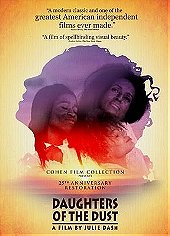Julie Dash’s directorial debut, Daughters of the Dust, explores a legacy of slavery never given resonance or thought in American history, fiction, or cinema. Here is the Gullah island culture writ large and given a chance to reveal itself to a wider audience. Dash’s camera is less of a coherent narrative then it is a poetic, near novelistic exploration of family legacy that rolls backwards and forwards through time revealing or filling in details as it goes.
What emerges is a rapturously beautiful film that is involving in how mysterious it is. The Gullah dialect and language are difficult to traverse at first but soon becomes immersive and easier to grasp as the film goes along. It is largely told through the faces and voices of black women and girls as their family prepares to leave Ibo Landing and move to the mainland to start a new life. That’s the entirety of the narrative, but it’s also so much more than that in a way that can’t quite be described properly. It can only be experienced.
The film is narrated by an unborn child, the latest generation of the Peazant family, who explains the family history and is described by the current matriarch of the family as her spiritual twin, “the last of the old and the first of the new.” Ancestry, legacy, and the old ways conflict with the modernity of the early 1900s throughout, as do various interpersonal conflicts between family members. Dash’s camera is an ever expanding and unspooling series of exquisite character sketches done in miniature.
The vibrancy of the imagery of her camera underscores just how dream-like and aggressively against straight interpretation the film can be. Dash isn’t interested in detailing straight historical artifacts but in immersion in a culture as it could be, such as giving all her elderly characters permanently blue-tinted hands to reflect their work on an indigo plantation. It’s a detail that feels real but may not necessarily be true.
There’s also the way her use of color tilts towards the sensual and rhapsodic rather than the mundane or the real. The sands of the beaches are glorious, the variation of black skin a marvel, and the white dresses, their faded Sunday best, a gorgeous parade of variations. Dash’s camera recalls Technicolor’s cinema-from-the-firehose unreality, and Daughters of the Dust is all the better for her refusal to play anything straight.
 Login
Login